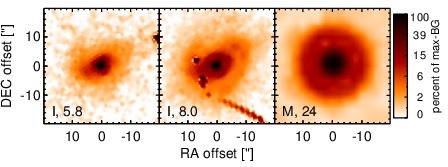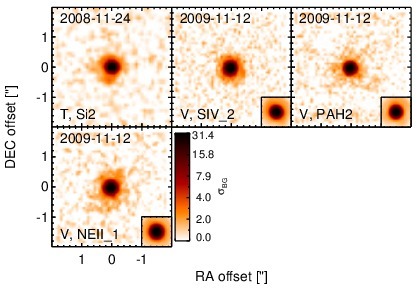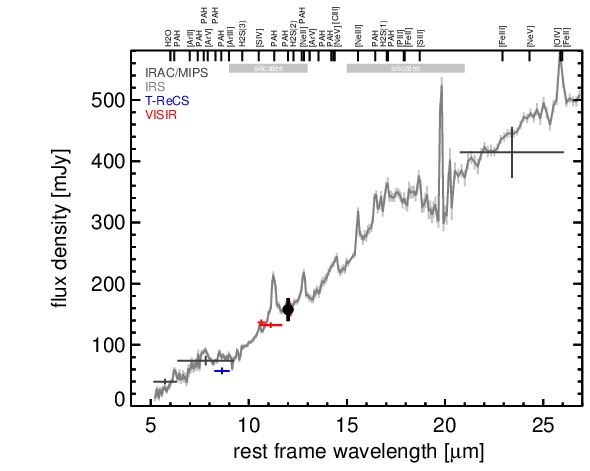Sasmirala Individual Information for ESO 362-18
Description
ESO 362-18 is a perturbed spiral galaxy at a redshift of z = 0.0124 (D ~ 52.1 Mpc) hosting a Sy 1.5 nucleus [veron-cetty_catalogue_2010] with an extended narrow-line region [fraquelli_extended_2000], which is a member of the nine-month BAT AGN sample. It was observed with Palomar 5 m/MIRLIN in 1999 in a broad N-band filter with a marginally resolved MIR nucleus being detected [gorjian_10_2004]. ESO 362-18 was also observed with Spitzer/IRAC, IRS and MIPS. The IRAC 5.8 and 8.0 μm images show weak host galaxy emission despite streak-like artefacts apart from the compact nucleus, which is also detected in the MIPS 24 μm image. Our nuclear IRAC 5.8 and 8.0 μm photometry yields significantly lower fluxes than those published in [gallimore_infrared_2010], which is probably caused by the different measurement method and the surrounding host emission. The IRS LR mapping spectrum shows strong PAH emission features and peaks at ~ 18 μm in νFν-space (see also [wu_spitzer/irs_2009, gallimore_infrared_2010]). ESO 362-18 was observed once with T-ReCS in one narrow N-band filter in 2008. Note that no standard star could be identified for this observation, and we use the median conversion factor for the absolute flux calibration of the T-ReCS measurement. In addition, we observed it with VISIR in in three narrow N-band filters in 2009. The nucleus is clearly detected in all images, while surrounding host emission might be marginally detected in particular in the Si2 and NEII_1 images. The nucleus is unresolved in the sharpest image (PAH2) and thus classified as unresolved in the MIR at subarcsecond scales. The measured nuclear fluxes of the VISIR images agree with the Spitzer spectrophotometry except for the PAH2 measurement, which indicates that the PAH 11.3 μm feature is absent in the subarcsecond MIR spectrum. This also agrees with the T-ReCS Si2 measurement, which indicates the PAH 8.6 μm is absent as well. We conclude that the star formation affecting the Spitzer spectrophotometry is probably not originating from the inner ~ 85 pc of ESO 362-18.
- [fraquelli_extended_2000] Henrique A. Fraquelli, Thaisa Storchi-Bergmann, and Luc Binette. The extended narrow-line region of the seyfert 1 galaxy ESO 362-g18 versus that of the seyfert 2 galaxy ESO 362-g8 . ApJ , 532 pp. 867–882, April 2000.
- [gallimore_infrared_2010] J. F. Gallimore, A. Yzaguirre, J. Jakoboski, M. J. Stevenosky, D. J. Axon, S. A. Baum, C. L. Buchanan, M. Elitzur, M. Elvis, C. P. O'Dea, and A. Robinson. Infrared spectral energy distributions of seyfert galaxies: Spitzer space telescope observations of the 12 μm sample of active galaxies . ApJS , 187 pp. 172–211, March 2010.
- [gorjian_10_2004] V. Gorjian, M. W. Werner, T. H. Jarrett, D. M. Cole, and M. E. Ressler. 10 micron imaging of seyfert galaxies from the 12 micron sample . ApJ , 605 pp. 156–167, April 2004.
- [veron-cetty_catalogue_2010] M.-P. Véron-Cetty and P. Véron. A catalogue of quasars and active nuclei: 13th edition . A&A , 518 pp. 10, July 2010.
- [wu_spitzer/irs_2009] Yanling Wu, Vassilis Charmandaris, Jiasheng Huang, Luigi Spinoglio, and Silvia Tommasin. Spitzer/IRS 5-35 μm low-resolution spectroscopy of the 12 μm seyfert sample . ApJ , 701 pp. 658–676, August 2009.
Images

Optical image (DSS, red filter). Displayed are the central 4 arcmin with North being up and East to the left. The colour scaling is linear with white corresponding to the median background (BG) and black to the 0.01% pixels with the highest intensity.

Spitzer MIR images. Displayed are the inner 40 arcsec with North being up and East to the left. The colour scaling is logarithmic with white corresponding to median BG and black to the 0.1% pixels with the highest intensity. The label in the bottom left states instrument and central wavelength of the filter in micron (I: IRAC, M: MIPS).

Subarcsecond-resolution MIR images sorted by increasing filter central wavelength. Displayed are the inner 4 arcsec with North being up and East to the left. The colour scaling is logarithmic with white corresponding to median BG and black to the 75% of the highest intensity of all images in units of sig_bg. The inset image (where present; either bottom or top right) shows the central arcsecond of the PSF from the calibrator star, scaled to match the science target. The labels in the bottom left state instrument and filter names (C: COMICS, M: Michelle, T: T-ReCS, V: VISIR).
SEDs


MIR SED. The description of the symbols in all the SED plots (where present) is the following: Grey crosses and solid lines mark the Spitzer/IRAC, MIPS and IRS data. The colour coding of the other symbols is as follows: green for COMICS, magenta for Michelle, blue for T-ReCS and red for VISIR data. Darker-coloured solid lines mark spectra of the corresponding instrument. The black filled circles mark the nuclear 12 and 18 micron continuum emission estimate from the data (where present). The ticks on the top axis mark positions of common MIR emission lines, while the light grey horizontal bars mark wavelength ranges affected by the silicate 10 and 18 micron features.